
The sweet potato or sweetpotato is a dicotyledonous plant that belongs to the bindweed or morning glory family, Convolvulaceae. Its large, starchy, sweet-tasting tuberous roots are used as a root vegetable. The young shoots and leaves are sometimes eaten as greens. Cultivars of the sweet potato have been bred to bear tubers with flesh and skin of various colors. Sweet potato is only distantly related to the common potato, both being in the order Solanales. Although darker sweet potatoes are often referred to as "yams" in parts of North America, the species is not a true yam, which are monocots in the order Dioscoreales.
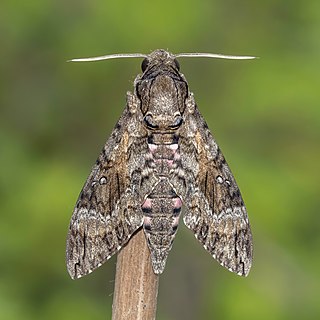
Agrius cingulata, the pink-spotted hawkmoth or sweetpotato hornworm, is a moth in the family Sphingidae. The species was first described by Johan Christian Fabricius in 1775.
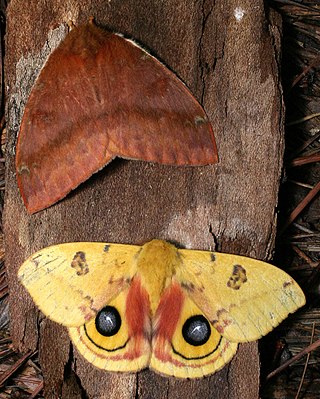
Automeris io, the Io moth or peacock moth, is a colorful North American moth in the family Saturniidae. The Io moth is also a member of the subfamily Hemileucinae. The name Io comes from Greek mythology in which Io was a mortal lover of Zeus. The Io moth ranges from the southeast corner of Manitoba and in the southern extremes of Ontario, Quebec, New Brunswick and Nova Scotia in Canada, and in the US it is found from Montana, North Dakota, South Dakota, Nebraska, Colorado, New Mexico, Texas, Utah, east of those states and down to the southern end of Florida. The species was first described by Johan Christian Fabricius in 1775.

Lomographa bimaculata, the white-pinion spotted, is a species of geometer moth. It belongs to the large geometer moth subfamily Ennominae, and therein to the tribe Baptini. It is – under its junior synonym – the type species of its genus Lomographa. It is also the type species of Bapta, a junior objective synonym of Lomographa and the namesake of the Baptini. The species was first described by Johan Christian Fabricius ion 1775.

Polygrammodes is a genus of moths of the family Crambidae.

Eupithecia venosata, the netted pug, is a moth of the family Geometridae, first described by the Danish zoologist Johan Christian Fabricius in 1787. It is found across the Palearctic realm from Portugal and Morocco in the west to the Lake Baikal in Siberia and Afghanistan and Pakistan in the east.

The Nokia 5230 is a smartphone manufactured by Nokia, running Symbian OS v9.4, S60 5th Edition. It was released in November 2009 after being announced in August of the same year.
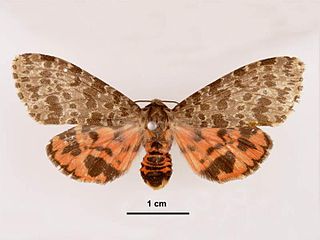
Olepa ricini is a moth of the family Erebidae first described by Johan Christian Fabricius in 1775. It is found in Bangladesh, India, Nepal, and Sri Lanka. An older treatment placed the species in the genus Pericallia.
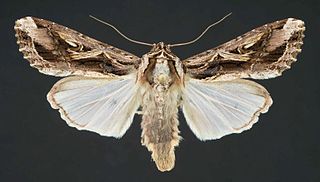
Spodoptera dolichos, the dolichos armyworm moth or sweetpotato armyworm moth, is a moth of the family Noctuidae. The species was first described by Johan Christian Fabricius in 1794. It is found from the southern United States, south through Costa Rica to South America, as far south as Argentina. In the United States, it may occur as far north as Kentucky and Maryland.

Syngamia florella, the orange-spotted flower moth or red waisted florella moth, is a moth of the family Crambidae. It was described by Caspar Stoll in 1781. It is found from South Carolina to Florida and from Arkansas to Texas, south to the West Indies and through Mexico to Argentina. It is also found on Bermuda.
Thliptoceras polygrammodes is a moth in the family Crambidae. It was described by George Hampson in 1899. It is found in South Africa.
Ercta vittata is a moth in the family Crambidae. It was described by Johan Christian Fabricius in 1794. It is found in the West Indies and South America. It has also been recorded from Costa Rica and southern Florida.
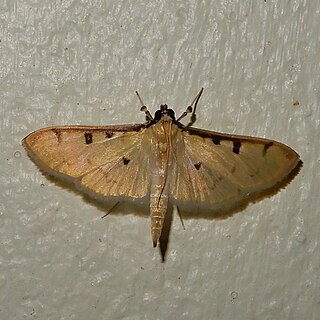
Lygropia tripunctata, commonly known as the sweetpotato leafroller, is a species of moth in the family Crambidae. It was first described by Johan Christian Fabricius in 1794. It is found in the United States, where it has been recorded from Texas to South Carolina and Florida. It is also found from the West Indies and Central America to Brazil.
Parotis marinata is a moth in the family Crambidae. It was described by Johan Christian Fabricius in 1784. It is found in India, Sri Lanka, New Guinea, on the Solomon Islands, the Democratic Republic of the Congo, South Africa. and Australia.
Polygrammodes oxydalis is a moth in the family Crambidae. It was described by Achille Guenée in 1854. It is found in the southern United States, where it has been recorded from Georgia, Florida and southern Texas. It has also been reported from Costa Rica.

Polygrammodes sanguinalis is a moth in the family Crambidae. It was described by Herbert Druce in 1895. It is found in Texas, Mexico (Veracruz), Guatemala, Costa Rica and Panama.
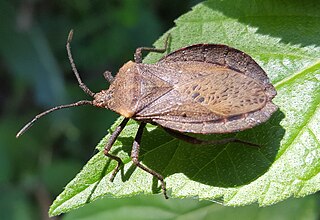
Spartocera batatas, commonly known as the giant sweetpotato bug, is a species of leaf-footed bug in the family Coreidae. It is found in the Caribbean, South America, and North America.
Red Sound Systems are a British manufacturer of music equipment. In the past, the company has manufactured the Darkstar and optional Vocoda kit, the Darkstar XP2 and Elevata synthesizers. The company has also manufactured DJ equipment such as the Federation BPM FX Pro and the Beat Xtractor1.














